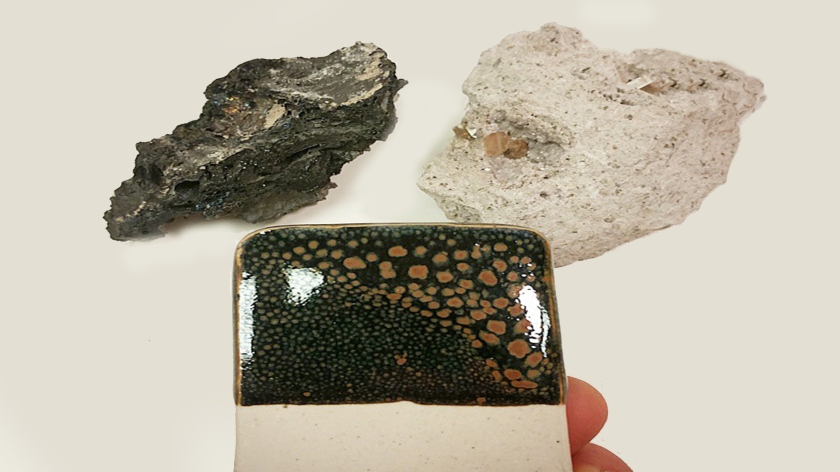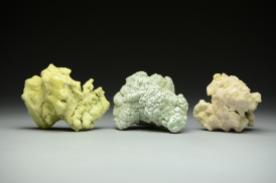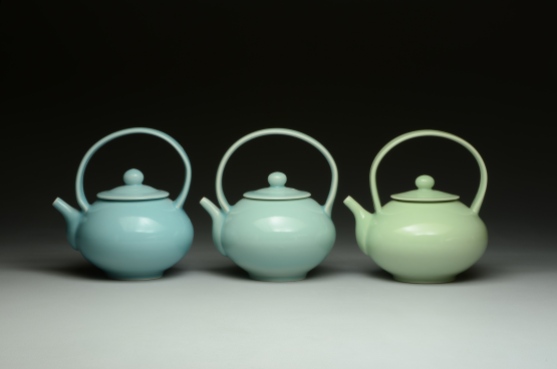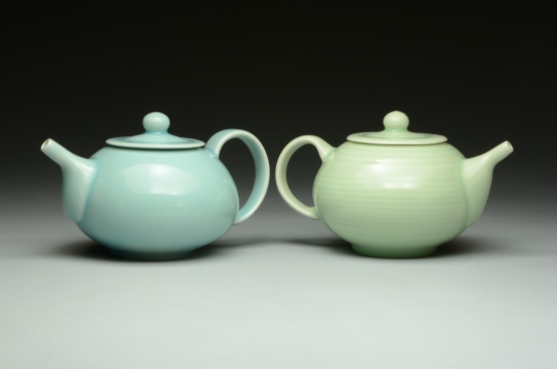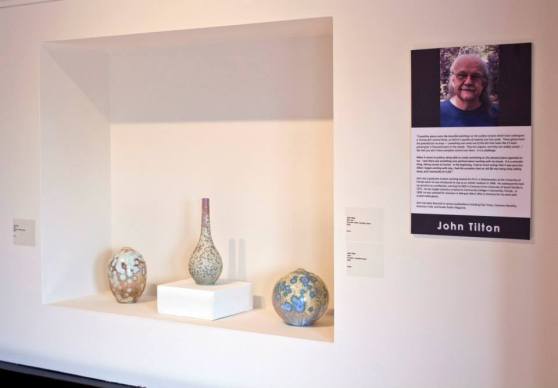Artist Bio/Statement
Bio
Matt was born in Carbondale, Illinois and grew up in Southern Indiana. In 1999 he was introduced to ceramics in high school. Matt earned his BFA in Ceramics and Art History from Indiana University in 2007. During this time he spent significant time living and traveling in China, studying the history and technology of Chinese porcelain. After graduating from IU, he spent several years living in Seoul, South Korea. Before coming to Graduate school at USU, Matt was a ceramics artist in residence at the Armory Art Center in West Palm Beach, Florida. He was the first recipient of the USU X-STEM fellowship, and his research involves material science, geology, and ceramics.

Artist Statement
Daily life plays an important role in what I make and why. The needs of the kitchen and home are for me, like many potters, a useful starting point for conceiving specific utilitarian forms. I make a lot of cups, bottles, and drinking vessels. Lately I’ve been interested in the idea of designing and making these vessels in sets. For me, there’s nothing better than gathering with a group of friends, eating, drinking, and using handmade ceramics. I’m motivated to make objects that enhance these experiences and enliven domestic spaces.
My work explores the intersection of ceramics, material science, and geology. In my mind’s eye, glaciers give way to icy celadon glazes, volcanoes ooze magma as molten glazes cascade down curves and roll off edges, crystals grow and forms take shape when conditions are right. I’m an avid rock hound, and for the past three years I’ve explored the mountains and landscapes of Utah, Idaho, and Montana. There are many gemstones that have analogues in ceramics – and much of my research has been centered on studying and understanding the underlying science of materials and firing processes. For me there is something incredible and romantic about the idea of transforming rocks and dirt into beautiful things.
In the end I strive to integrate my desire to make utilitarian pottery with a love of materials and nature. What drew me in and keeps me interested on a daily basis are the endless variations possible in ceramics. The idea of constantly searching for new possibilities is at the heart of who I am and why I do what I do. At the same time, I love the constant challenge of pairing forms and surfaces, sourcing from the history of ceramics as I source materials from my local surroundings. I think my strongest work finds a balance between all of these ideas, and my hope is that my work evokes a similar curiosity in the people who see and use it.
Exhibition Statement
Pyrosynthesis: n. synthesis or creation initiated by or resulting from the action of heat.
I like to joke that I’m equal parts artist, pyromaniac, rock hound, and nerd. Add to that an interest in history and technology, along with a penchant for experiments and testing, and it describes who I am and what I do quite neatly. As a graduate student in ceramics at Utah State I’m in the perfect place to satisfy all of these interests. For the past three years I have specialized in the transformation of common raw materials into ceramics through the action of heat and fire – hence the title. There are a lot of parallels between what I endeavor to do, and what the alchemists of ancient history sought to do, namely to turn lead into gold. In my case, I’m interested in the transformation of locally abundant rocks and dirt into objects of beauty and interest.
This exhibition, then, is a culmination and presentation of my work on this subject. To explain it simply, all of the work in this gallery has at least one component of a prospected (dug up or picked up off the ground and drug back to my studio) material utilized in the finished piece. The best example is the granite bottle and cup set on the granite slab. In this piece, the glaze is made entirely out of the finely ground up granite rock dust. Coarser granite rock particles were incorporated into the clay body, thus providing black speckles on the unglazed clay surface. The base, too, is a broken granite boulder that has been cut and polished flat to provide a stone surface for the ceramic objects to live on. My hope with these combinations is to draw a direct connection between the ceramic object and the materials they come from. For me, the novelty of melting rocks in a ceramic kiln never gets old – each experiment generates still more new questions than answers, and Utah has been an amazing place to find all kinds of interesting materials. I’ve included 9 of the most interesting materials that have captured my interest.
Starting just to the right of this statement, I’ve included several piecess to help give context to my process and research and shed light on how the finished pieces come about. I should mention, too, that I took all of the 2 dimensional images with the Scanning Electron Microscope here on campus. I often study my experiments and tests for a long time before they end up on finished pots, and the SEM has given me the ability to analyze and learn about the materials and firing process in a way that I still can’t believe. Not only are these images a wealth of information and data, but from an artistic standpoint, I see them as dramatic landscapes and images of incredible beauty. Finally, the pots themselves are at the heart of everything. Over the course of my graduate studies at Utah State my sense of design and craftsmanship has been challenged like never before, the result of which is a body of work that is hands down the best I’ve ever made. Thanks for coming in and having a look around.
Local Materials

From Top to Bottom, Left to Right.
- Manganese Saturated Kaolinite/Halloysite from near Eureka, Utah.
Manganese is a very interesting element, and provides some wonderfully interesting surfaces. In certain conditions it can yield dramatic rainbow iridescence. Small additions account for the optical phenomena in the iridescent Hare’s Fur Glazes as well as the Manganese Saturate Glazes.
- Quartzite from Willard Canyon, Near Brigham City, Utah.
This is a rather interesting flavor of Quartz, having trace amounts of Chromium, which accounts for the lovely green color. It provides a very high concentration of Silicon Dioxide (glass) in glazes. It was used in the dark green Basalt Celadon glazes.
- Dolomitic Limestone with Calcite from Dry Canyon, Logan, Utah
The first material I began experimenting with at Utah State, this material is used in glazes as a glaze flux – which is to say, it’s a material that lowers the melting temperature and promotes flowing, dripping glazes. It’s used in all of the black Oilspot and Hare’s Fur glazes.
- Travertine from Porcupine Reservoir, Utah.
I picked this stuff up not knowing what it was, but fascinated by the texture. I later learned what it was and that it formed in chaotic hydrothermal conditions, you could think about this material as nature’s very own hard water deposit. Similar to the Dolomite, it acts as a flux in glazes. It was used in conjunction with the Dolomite and Quartize on the bluish grey teapot.
- Black Schist from Willard Canyon, near Brigham City, Utah.
Essentially a metamorphosed clay or shale, this flavor of slate contains some really beautiful pyrite (fools gold) inclusions. By itself it is refractory and unappealing, but with a 10% addition to a celadon base glaze, it provides a beautiful sky blue. You can see the blue and the pyrite inclusions on the blue bottle set.
- Topaz bearing Rhyolite, from Topaz Mountain, Utah.
This stuff is just amazing. High in Silica and Alumina, it also speckled with Topaz gemstones (mostly very small in scale – this sample is exceptional). It’s features in all of my Basalt/Rhyolite glazes, which I’ve named Fiske Lava Oilspot. The recipe? 3 Parts Rhyolite, 1 Part Basalt. See the small test tiles for what it looks like fired by itself.
- Granite from Cook Canyon, Near Willard, Utah
Plain old granite. It turns out this stuff makes a beautiful range of glazes completely by itself. Its used as a glaze on the 2 Tiered Granite Slab piece, and it’s used in the matte black glaze on the set of 4 cups on the smaller granite base. The matte black comes from an addition of 1 part Hematie (Iron Ore) to 4 parts Granite.
- Vesicular Basalt (Lava Rock) from Sid Butte, Idaho.
The local geology abounds with basalt of all flavors, but compositionally, they’re all relatively similar – at least as far as my glazes and firing process is concerned. This specific variety got me started on researching basalt glazes, and when I started using the lava oilspot glazes I incorporated local Utah varieties from outflows near Delta, Utah, as well as roadcuts off in Box Elder County, Utah. It accounts for the rich reds and oranges in my Lava Oilspot Glazes.
- Iridescent Hematite from near Eureka, Utah
This spectacular sample survived my hammer and the studio milling equipment. It’s nearly pure iron. Less spectacular examples have been incorporated into all of the Iridescent Hare’s Fur Glazes and Black Oilspot Glazes, as well as the Black Granite Cup Set.
Making a Glaze
A glaze is nothing more than a glass-like coating fused to a ceramic surface by heat.
Nearly any rock or mineral can be utilized in a glaze. Most ceramics studies are stocked with materials that have been mined and commercially prepared for consistency and ease of use. But you can easily dig up anything and see what happens, sometimes it’s not at all useful for ceramics, but sometimes it is – and these are wholly unique to the place you get them from.
- The first thing I do when I bring back a sample (1a,1b) to my studio is to use my trusty sledge hammer to break a small sample into pea-sized gravel. This gravel then goes straight into a small bowl (1c), and straight into a kiln. After this initial firing to 1250C (2350F – that’s HOT!), I can usually get a very good idea of what a sample might do in glazes. I might not have any idea what a material is – but after firing it, you can tell how it will behave at standard ceramic temperatures. Sometimes one gets lucky (as was the case with the granite) and ends up with a material that makes a perfectly acceptable ceramic glaze all by itself. Usually though, it takes some testing to find out how to fire specific materials.
- Because the atmosphere in the kiln has an effect on the color of the glazes it’s useful to do initial melt tests in an oxidized (regular atmosphere) firing (2a) as well as firing the material in a reduction (excess fuel, reduced oxygen atmosphere) (2b) The firing atmosphere changes the color of the clay and the material quite significantly. My Oilspot glazes rely on regular atmosphere firing conditions for the phenomena of oilspots to occur. Celadon glazes, on the other hand, require reduced oxygen conditions for the iron to change from it’s oxidized (rust!) red color, to a reduced black color. These tiny black iron molecules are what make my celadon glazes appear blue.
- (3) is a sample of granite melted at 1250C. Right away I could tell this was going to be a great material to work with. With no additions it’s good to apply directly to pots as soon as it’s milled. The liquid in (6b) is pure granite glaze.
- (4) is a sample of Black Schist melted at 1250C. You can see that this sample needs to be amended or mixed with another material to make a useful ceramic glaze.
- It can be useful to fire samples at lower temperatures to find out when exactly they start to melt and fuse to a clay surface. (5) is a sample of basalt fired to about 1000C, which was hot enough to affect the iron in the basalt, but not enough to melt the bulk of the other minerals present.
- After establishing that a rock is going to be useful, it’s time to begin preparing it for use as a glaze. A 15 pound (bowling ball sized) hunk of rock will provide about 5 gallons of glaze. 5 Gallon buckets are a standard in most studios, and I used about 5 gallons worth of glaze to finish all of the black and Hare’s Fur Oilspot pieces in this exhibition. Making a rock a glaze material is a rather simple process of using a hammer or milling machine to crush rocks into fine powder. My favorite way to do this is to use a ball-mill, which is essentially a heavy-duty rock tumbler. To a tightly sealed metal jar you add: 3 Parts material, 3 parts water, 4 parts porcelain balls(6a). Put this jar on a machine that spins, and in about 24 hours it does the job that takes Mother Nature millions of years (who is constantly turning mountains into clay). The mill works by mechanically mixing and breaking the material into finer and finer pieces. Your done when the material (6b) passes through a fine mesh strainer. You can then dry it out and use it like any other ceramic raw material (6c) or you can dip or apply it directly onto pottery or test tiles (7).
Basalt, Iridescence, and the Firing Process

In the course of poking around and looking at rocks in Idaho, one particular sample of basalt caught my attention. The iridescent vesicular basalt on the right an example of what I picked up. I became very interested in the question of why this material had a bluish iridescent metallic sheen – and why the rocks next to it didn’t. I speculated that since some ceramic glazes can be fired in ways to make them turn iridescent (raku firing, for example) it might just be the case that I could fire basalt in a way that it would turn out with the same lustrous metallic surface.
I then set about testing my theory. I started by making nine 8” stoneware tiles, which would all have the same application of the same ground basalt. I then designed a series of firing schedules where I would change two variables: 1.) Atmospheric Conditions Inside The Kiln – specifically whether I would keep the kiln in oxidized natural atmosphere or whether I would reduce the available oxygen by firing in a gas rich environment. 2.) Cooling Speed. Of particular importance in the color of ceramic surfaces is the speed at which a molten, melted glaze cools down and crystallizes when the burners are shut off and the kiln returns to room temperature. In this series of firings, I took careful notes, paying very close attention to both the atmosphere in the kiln and the rate at which I allowed the kiln to drop in temperature.
I did indeed find that I could reproduce a metallic iridescent blue sheen from basalt lava rock (see the tile in the middle). The trick was to fire the kiln normally, and then cool the kiln very rapidly to about 1000C (which is the stage in which the viscous, molten material starts to harden) and then hold the kiln at a steady temperature in a reduced oxygen environment for an hour or two, then begin a very slow -2 degree per minute drop in the same reduced oxygen environment until the glaze had completely solidified around 700C.
What I learned through this series of experiments is that the iron in basalt and other iron rich glazes is greatly influenced by rate of cooling and atmosphere. By manipulating the atmosphere and rate of cooling, I could affect the colors of glazes – thereby producing unexpected surfaces and colors. It was this research that then led me to develop all of the variations found in both of the installation pieces in this show. The glazes are the same- but the firing processes are very different.
Rhyolite/Basalt Glaze (Lava Oilspot Glaze)

While it was exciting to work with basalt as a material, in most cases it left something to be desired as a functional, utilitarian ceramic surface. It had the tendency to run completely off the pots, and it often had a blistered, matte surface. Very few glazes in ceramics contain one singular material, sometimes a glaze recipe can call for as many as 20 different materials. I needed to add something to my basalt to make it more functional, and a breakthrough came after my Mineralogy class fieldtrip to Topaz Mountain, in Southwest Utah where I collected a 5 gallon bucket of Rhyolite gravel.
Rhyolite, which is another volcanic rock and it lies on the on the other end of the spectrum of igneous rocks. Rather than being high in Iron and Magnesium like Basalt, Rhyolite is very high in Silica and Alumina. In glaze chemistry, you can think about Alumina as the opposite of a flux. Rather than lowering the melting temperature, it raises it. Referring back to the local materials in this show, you might notice that I’m using Dolomite and Travertine to increase the melting and moving of glazes in the kiln. Conversely, I’m using Rhyolite to stiffen and slow down the melting of the glazes.
Often the first experiment to do with a prepared local material is to do what’s called a line blend. The five pieces on the shelf below are what are called test tiles, because it’s often not feasible to devote a piece of pottery to a glaze you don’t know much about. In a line blend, you move in steps from one material to another. The tiles below represent a progression from 100% Basalt , to 75:25, to 50:50, to 25:75, then to 100% Rhyolite. In other words, on one end of the line you have one material, in the middle you have a perfect mix of the two, and on the other end of the line you have the other material. You can move in big steps, which takes less time, or you can move incrementally. The point then, for a line blend is to help you narrow in on a nice proportion, and sometimes a second series will help you narrow it down further – say the 50:50 and the 75:25 test tiles look very promising, you might then decide to do a second progression from 50:50, 55:45, 60:40, 65:35, 70:30, and then 75:25. The possibilities are endless, and you can add in a third and fourth material to the blends and very quickly use up a lot of test tiles and explore a lot of variations. I’ve also included some of my notes, which cover only a few of the thousands and thousands of glaze tests I’ve mixed and fired.
I was lucky though and the first line blend yielded my Lava Oilspot Glaze. It’s 1 part Basalt, 3 parts Rhyolite. A very simple glaze recipe for sure. But remembering also that the firing and cooling have a great deal of influence on the finished surface, I’ve spent the last year investigating the possible variables on this very simple recipe with very, very complicated firing and cooling processes. The results of which are the 16 Rhyolite/Basalt Bowls, all of which were made from the 1:3 recipe, but fired in very different kiln cycles. I’ve also included some examples of several of my firing cycles.

The Scanning Electron Microscope

My research with the SEM on campus began with a generous scholarship from the Office of Research and Graduate Studies. With my membership to the Microscopy Core Facility, I was able to take my own samples and prepare them for analysis on a state of the art Quanta Scanning Electron Microscope. Fen-Ann Shen, who oversees the SEM was a patient teacher, and she taught me first how to use the equipment on calibration samples, and then later, to prepare my own ceramics and begin looking at the surfaces and structures on the nano-scale.

It should be said that an SEM is not an optical microscope – and by that I mean it’s not what you’d normally imagine a microscope to be, namely, a tabletop instrument with two lenses that you look in. While optical microscopes are useful for looking at surfaces, magnification maxes out at about 800-1000 magnification. An SEM, on the other hand, operates on the principal of firing a concentrated beam of electrons at a sample and analyzing the electrons as they bounce back (backscattered). Scanning is in the name because this beam moves across the surface of the sample, building an image as the resulting information is compiled. While an optical microscope maxes out at around 1000x, the SEM at USU is capable of 300,000x magnification. In effect, you can look at nano-particles in high resolution. That’s 1/1,000,000,000 of a meter! A human hair is about 100,000 nano-meters in diameter. It’s therefore quite easy to get completely lost in an area smaller than an eighth of an inch.

The images in this exhibition represent some of the most exciting surface features and topographies from my own glaze. To date I’ve only looked at 3 glazes, and all of them are in this exhibition. I’ve included the actual samples themselves, which are mostly broken shards and chips of glaze. As I began to learn more about the equipment and preparation, I began to make samples specifically to fit on the small conductive sample mounts.
I might also add that these images represent the very beginning (I’ve spent less than 20 hours looking at my glazes) of what I see as a very exciting chapter in my exploration of materials and glazes. Most published images are the result of hundreds, if not thousands of hours spent in front of the monitor, patiently waiting for scans to complete. I was lucky, then, to capture the images I did, and I’m very excited to continue this research in the future.
Acknowledgements
A special thanks to The Office of Research and Graduate Studies along with The Caine College of the Arts for providing me with an incredible ART-STEM fellowship – without this funding, it wouldn’t have been possible for me to devote all of my time and energy to focus on my research. My fellowship has opened doors to departments across campus, and has facilitated a great amount of collaboration and research outside of the Department of Art and Design.
Thanks to the USU Ceramics Faculty for giving me a long leash to play around and melt things and make messes – and thanks also for reigning me in when I got carried away and always reminding me that I can’t fire kilns without actual work. Without craftsmanship there is no concept.
Thanks to my Graduate Advisory Committee for helping me decide what I should be doing, not what I could be doing. Thanks also to John Shervais and the Geology Department for help with my projects and insight into material science.
Thanks to Kenzi Lowry for help with the graphic design of my postcards and posters and helping me format the SEM images and get them ready for printing. Thanks for working under impossible deadlines and tolerating my constant adjustments and second guesses and indecisiveness.
Thanks to Fen-Ann Shen for training me on the use of the Scanning Electron Microscope and helping me figure out how to prepare and analyze my ceramic samples. I look forward to investigating more materials in the Microscopy Core Facility.
Thanks to Nicholas Gialanella for providing me access to the printers in Photography and working with me to produce the SEM images.
Thanks to Ryoichi Suzuki, who had a huge influence on my thinking about the possibilities of stone and for giving me access to the sculpture facilities.
Thanks to Miles Howell for his help in preparing and roughing out the stone bases – he got done in hours what would have taken me days!
Thanks to all of my graduate and undergraduate colleagues in Ceramics, for putting up with my messes and firings, and for inspiration and camraderie. Also, a shout out to the corner for the tough love.
A final thanks to The Department of Art and Design. Laura, Becky, Tori, and Janet, you’ve all been incredibly helpful and supportive not just in the run up to this show, but throughout my time at USU. Thank you!




